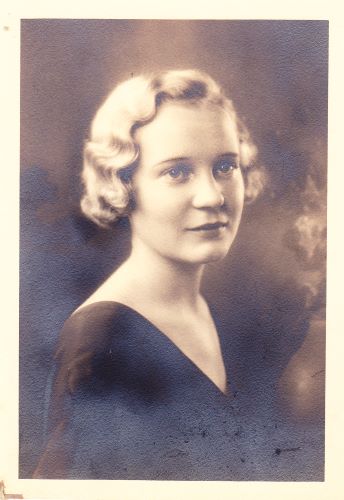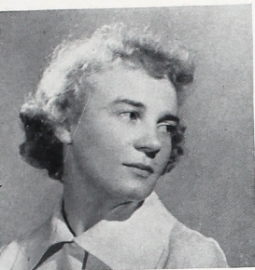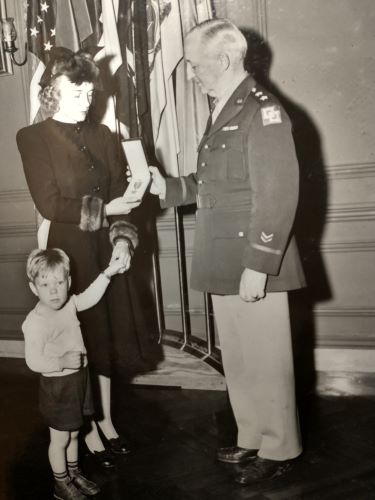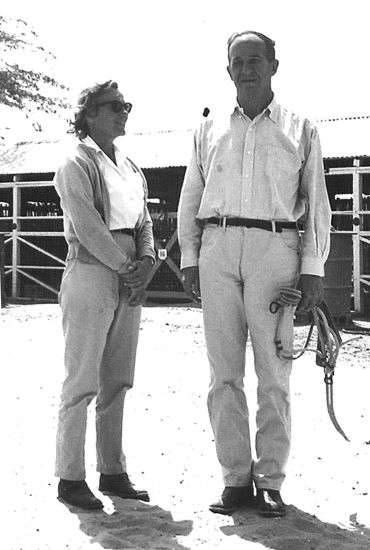The first weekend Margaret Shedden met her future mother-in-law Katherine Marshall, “Madge” was impressed by Katherine’s poise in an awkward situation. Madge and her fiancé, Allen Brown (Katherine’s son) rode with Gen. George Marshall, Katherine, and their dog Fleet to visit newly purchased Dodona Manor, about an hour from Washington, D.C. As Madge told the story years later:
General Marshall was driving. Mrs. Marshall was in the front seat with Fleet, their dalmatian dog. And Allen and I were in the back. And about halfway down, Fleet threw up all over Mrs. Marshall’s skirt. General Marshall stopped the car.
Alongside of the road there was a ditch with some water in it. She got out of the car. Took off her dress which I remember, it was sort of a black and white print silk dress. Dipped it in the ditch, washed it, wrang it out. Put it in the back of the car someplace and got back in in her slip and we continued to Leesburg. I think only an accomplished actress could have showed that presence of mind and handled that situation so well.
Madge had been raised to be a leader and intellectual thinker while still being a lady, and Katherine’s example must have made quite the impression to be remembered. Madge grew up in New York, and for high school attended the all-girls Emma Willard School.

Madge at the Emma Willard School.
She pursued her education at Vassar College, where she worked on the editorial staff at the Vassar Miscellany, the student newspaper, and graduated in 1937.

Madge at Vassar.
After graduation, Madge worked at the New York Times, and this is likely where she met Allen Brown. Madge and Allen were married June 22, 1940, at Mt. Kisco, NY, with both Madge’s and Allen’s families in attendance. After a honeymoon trip to Bermuda, Madge and Allen settled in Poughkeepsie, NY, where Allen worked for WGNY, a local radio station.
In September, 1941, Madge and Allen celebrated the birth of their son, Tupper. They asked Gen. Marshall to be his godfather, which pleased Marshall greatly.
Just over a year later, Allen enlisted in the Army, and was commissioned an officer in Armor. Madge was hired as a journalist at the national news desk for Life magazine. After Allen deployed to Europe with the First Armored Division, Madge wrote to the Marshalls, and and she and Tupper visited whenever time and distance allowed.
The communication Madge hoped never to get arrived at the end of May 1944. It came from her father-in-law, “I have just received a message from General Clark commanding Fifth Army that Allen was killed in his tank by a German sniper at ten AM May 29th near Campoleone. General Clark has sent for Clifton. Katherine is leaving here by plane at ten o’clock for New York and will go direct to your apartment.”
Madge was not at home to receive the telegram; although it was Decoration Day (precursor of Memorial Day), it was not a holiday at Life magazine, so Madge was at work like any other day. She got a phone message that Katherine was in New York to visit, but Madge was not concerned as Katherine had made a point of seeing Madge and Tupper whenever traveling brought her to New York.
It wasn’t until Madge walked into her apartment building and saw Katherine with several aides from the War Department did she realize something was very wrong. Madge reported, “Going up in the elevator she (Katherine) told me that Allen had been killed. That’s how I learned.”
Madge, like other war widows, kept moving forward. Just a few days later she took care of some shopping for Marshall, and traveled to Wisconsin for a Life story. She did take a significant break that summer and she and Tupper spent several weeks in Virginia with the Marshalls.
That fall, Madge and Tupper traveled to the War Department in Washington, D.C., for the awarding of posthumous medals for Allen. She was reluctant to be the center of attention, but was encouraged by Marshall who told her, “were he (Allen) receiving the decoration I could understand his decent reticence about having the matter publicized, particularly in view of his relationship to me, but under the present circumstances my own assumption is that he would be gratified to know that what he did and what he suffered was not ignored, in a world which only too quickly forgets the sacrifices people make.”

Madge receiving a posthumous award for Allen at the Pentagon, fall of 1944.
Madge continued to be a part of the Marshall family, visiting with Marshall and Katherine often, and continued work as a journalist. She and Tupper moved to Georgetown, very close to Washington, D.C., when she took a job with Reporter magazine. When Marshall served as Secretary of State, he had a room at Madge’s so that he didn’t have to drive all the way out to Leesburg each night. Madge explained,
What he wanted was a pied-a-terre during the week where he could stay incognito. And so when he heard that I decided to move down here with Tupper because I thought it would be a much better and easier place to live than the middle of Manhattan island, he asked me to find a house with an extra room for him. So I did.
And that’s how it came about that I had the Secretary of State under my roof during that whole period. And it was a huge secret. Nobody knew about it. And it really worked very well.
He really liked having a place to come in the evenings where there was somebody to talk to and not have to stay by himself in a hotel or a lonely apartment. And we had a nice, casual household. He would make us two old-fashioneds before dinner and we would have those. And we led a rather simple life.
In June 1949, Madge married John W. Pendleton, a foreign affairs analyst on the Middle East at the CIA. Letters between Madge, John and the Marshalls continued unabated. Marshall happily wrote a note to Madge in the hospital after the birth of John and Madge’s first of three children, and there are many letters to the family in the states and overseas.

Madge and John
John’s career took the family to Saudi Arabia with ARAMCO, an oil company, in 1956, and the family could not get home for Marshall’s funeral. They sent Katherine a heartfelt telegram from Dhahran.

Telegram sent just a few hours after Marshall’s death.
Madge was widowed again in 1971, but continued her life as a journalist. She helped found the Middle East Editorial Associates publishing company. She was also editor of the Middle East Journal; as well as a writer and editor for the American University of Beirut, America-Mideast Educational and Training Services Inc. She kept an apartment in both Lebanon and Washington, D.C. during these years.

Madge died in 2006, just a few weeks shy of her 90th birthday. She is buried with John in Lexington, VA.
Special thanks to Tupper Brown, who graciously shared stories and photos of Madge.
Before becoming director of library and archives at the George C. Marshall Foundation, Melissa was an academic librarian specializing in history. She and her husband, John, have three grown children, and live in Rockbridge County with three large rescue dogs. Melissa is known as the happiest librarian in the world! Keep up with her @MelissasLibrary.
